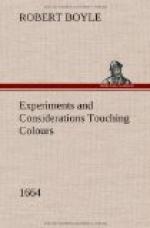CHAP. IV
1. Of greater Moment in the Investigation of the Nature of Colours is the Controversie, Whether those of the Rain-bow, and those that are often seen in Clouds, before the Rising, or after the Setting of the Sun; and in a word, Whether those other Colours, that are wont to be call’d Emphatical, ought or ought not to be accounted True Colours. I need not tell you that the Negative is the Common Opinion, especially in the Schools, as may appear by that Vulgar distinction of Colours, whereby these under Consideration are term’d Apparent, by way of Opposition to those that in the other Member of the Distinction are call’d True or Genuine. This question I say seems to me of Importance, upon this Account, that it being commonly Granted, (or however, easie enough to be Prov’d) that Emphatical Colours are Light it self Modify’d by Refractions chiefly, with a concurrence sometimes of Reflections, and perhaps some other Accidents depending on these two; if these Emphatical Colours be resolv’d to be Genuine, it will seem consequent, that Colours, or at least divers of them, are but Diversify’d Light, and not such Real and Inherent qualities as they are commonly thought to be.
2. Now since we are wont to esteem the Echoes and other Sounds of Bodies, to be True Sounds, all their Odours to be True Odours, and (to be short) since we judge other Sensible Qualities to be True ones, because they are the proper Objects of some or other of our Senses, I see not why Emphatical Colours, being the proper and peculiar Objects of the Organ of Sight, and capable to Affect it as Truly and as Powerfully as other Colours, should be reputed but Imaginary ones.
And if we have (which perchance you’l allow) formerly evinc’d Colour, (when the word is taken in its more Proper sense) to be but Modify’d Light, there will be small Reason to deny these to be true Colours, which more manifestly than others disclose themselves to be produc’d by Diversifications of the Light.
3. There is indeed taken notice of a Difference betwixt these Apparent colours, and those that are wont to be esteem’d Genuine, as to the Duration, which has induc’d some Learned Men to call the former rather Evanid than Fantastical. But as the Ingenious Gassendus does somewhere Judiciously observe, if this way of Arguing were Good, the Greeness of a Leaf ought to pass for Apparent, because, soon Fading into a Yellow, it Scarce lasts at all, in comparison of the Greeness of an Emerauld. I shall add, that if the Sun-beams be in a convenient manner trajected through a Glass-prism, and thrown upon some well-shaded Object within a Room, the Rain-bow thereby Painted on the Surface of the Body that Terminates the Beams, may oftentimes last longer than Some Colours I have produc’d in certain Bodies, which would justly, and without scruple be accounted Genuine Colours, and yet suddenly Degenerate, and lose their Nature.




